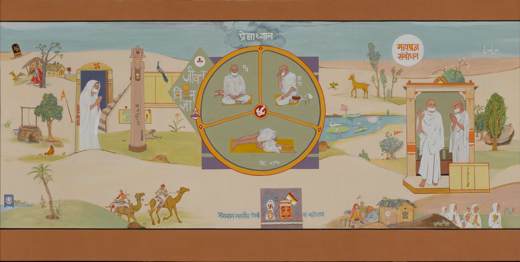(9th Acharya of Jain Swetambar Terapanth sect)
A Mural Painting by Dr. Manju Nahata
Size: 56 feet x 4 feet Base: Cloth mounted on the board Medium: Tempera, Earth colours
PREKSHA-DHYAN AND JIVAN VIGYAN
(Panel 5)

[ large size ]
The scene in panel 5 shifts to Rajasthan. In the nether part of the panel a logo of ‘Terapantha Yuvak Parishad’, established in Bikaner in 1964 with a motto of service, dedication, and organisation, is shown in a pink lotus. At the upper part of the panel, a black milestone with a logo of ‘Mahila Mandal’ (ma ma) inscribed on it is shown. The Mandal was established in 1968 in Bidasar. These two institutions have now spread all over India.
The picture of a woman, with a boy on her lap, is sitting near her hut, as though she is confined to her domesticity. Her face covered with a part of her sari is suggestive of the then Rajasthani women’s condition not to have exposures to the outside world. Acharya Tulsi opposed this age-old purda convention and he found it necessary that this convention, has to be removed. He successfully created awareness among them about their dignity and importance in social, intellectual and spiritual life.
To bring home the fact I have drawn the picture of a 25-year-old Sadhvi as a leader of ‘Sadhvigana’. She is called ‘Sadhvi Pramukha’. There is on her left a flight of staircase containing seven steps: this is suggestive of progress towards both intellectual and spiritual ends. The pillar, in front of her, shows ‘14.01.1972’ – the date and the year when she became Sadhvi Pramukha. The slogan, ‘Utthiye no pamayae’ (once awakened never be mistaken), is a call for advancement in mind and soul.
The panel, next, captures another major event in Acharya Tulsi’s life: showing the importance of the Jivan-Vigyan (Science of Life). He asked his disciple Muni Nathmal to give shape to this science through texts and discourses. There is a circle with three segments, each segment showing Muni Nathmal in Meditation, doing Pranayam, and Yoga for the realization of the bliss of solitude. The bliss of solitude is shown in an imaginative presentation of a naturally restless deer standing still as well as of two swans quietly floating on water and a reflection of the sun.
Below, this is shown an impression of the 2500 Nirvana Mahotsava of Bhagwan Mahavir in which all the Jain sects participated and a book entitled ‘Samana Suttam’ was published on that occasion. The flag that appears behind the book signifies the glory of the occasion as well as of the unification of all the sects for the occasion. Acharya Tulsi took great interest in all this and participated whole-heartedly for its success.
At the end of the panel we find Acharya Tulsi addressing Muni Nathmal and giving him the title Mahapragya in the year 1978. The sandal tree at the margin signifies that in future the fame and glory of Mahapragya will spread all over, as does the fragrance of sandal tree.
How advanced was Acharya Tulsi in his vision could also be realized in his attempt to introduce ‘Saman-Shreni’ in 1980, who might instead of practising difficult journey on foot, avail themselves of convenient transport system, when it comes to going places on mission.
 Dr. Manju Nahata
Dr. Manju Nahata